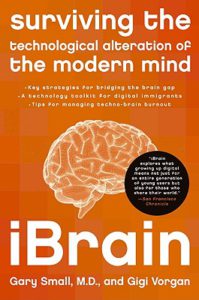Between 2008 and 2011, I wrote several brief reviews of books which appeared on the Education Review web site. Since then, the editors ceased publication of that type of review and removed the previously published brief reviews from the site. I am making the original drafts of my reviews available here.
By Dr. Gary L. Ackerman, June 2009
 As we near the end of the first decade of the 21st century, there is no doubt that information technology is influencing most every aspect of life in the modern world. Although there are examples of K-12 educators who are using information technology effectively, and there is evidence computers and Internet connections are available in K-12 schools, it is reasonable to conclude K-12 curriculum and instruction is one of the few activities in our society that proceeds largely as it did prior to the explosion of connected computers over the last three decades. iBrain is an excellent overview of what researchers have learned about the effects of connected computers on humans as the devices have become ubiquitous; it defines the new starting line for educators who have yet to join the 21st century.
As we near the end of the first decade of the 21st century, there is no doubt that information technology is influencing most every aspect of life in the modern world. Although there are examples of K-12 educators who are using information technology effectively, and there is evidence computers and Internet connections are available in K-12 schools, it is reasonable to conclude K-12 curriculum and instruction is one of the few activities in our society that proceeds largely as it did prior to the explosion of connected computers over the last three decades. iBrain is an excellent overview of what researchers have learned about the effects of connected computers on humans as the devices have become ubiquitous; it defines the new starting line for educators who have yet to join the 21st century.
iBrain is written for general readers, not specifically educators, but Small and Vorgan make two important contributions to the growing literature informing educators who seek to use technology to create meaningful learning environments. First, the authors review the research suggesting the human brain does changes in response to the connected computing environment. Second, the authors provide hope for those who are reluctant users of technology by summarizing the tools that should be in one’s repertoire and by arguing adults have an important role in helping digital natives become responsible users of technology.
Small is a medical doctor and Vorgan has experience writing for the popular culture. The result of their collaboration is a thorough review of research into issues such as continuous partial attention and online addiction that are affecting the individuals and the generations with whom K-12educators work in language that is understandable and entertaining. In addition, the authors review research documenting the cultural impact of information technology on families and other social groups. After the first six chapters, it is easy to conclude the future is bleak; Small and Vorgan describe a range of problems that should cause educators to be concerned about students and their families.
In the last three chapters, however, Small and Vorgan argue adults, including and especially educators, have a role in helping the digital generations develop healthy and responsible patterns of technology use and also that adults have a role in encouraging nurturing offline connections as well as appropriate online connections. Small and Vorgan do argue adults must become competent users of information technology if they hope to have any credibility with digital natives, however.
Educators who take the short time necessary to read this book will find themselves understanding digital natives and understanding the affects of technology on young humans brains and the culture in which young human brains develop today. Educators will also find themselves better prepared to adopt reasoned and informed approaches to using information technology in their work and responding to young people’s use of information technology.